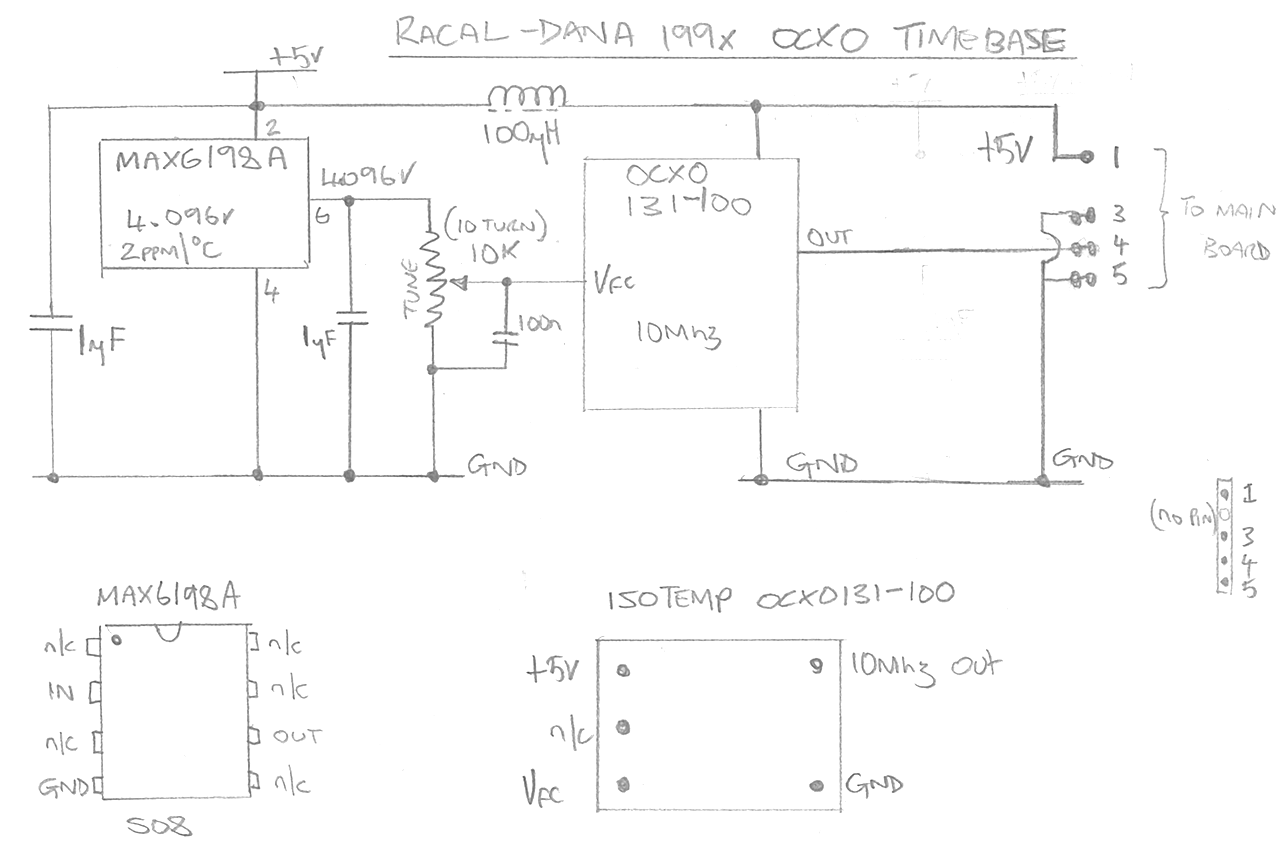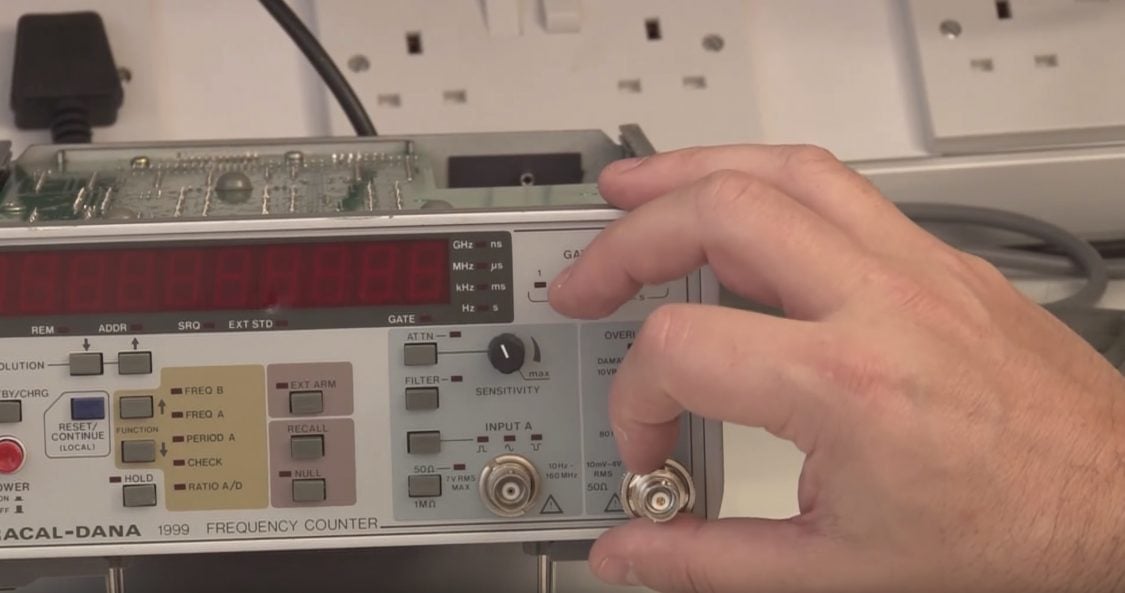Having played with a number of OCXO’s and a Rubidium standard I tried (after repairing it) to calibrate the standard timebase in my Racal-Dana 1999 counter which is actually a simple TCXO. I could get pretty close but it was touchy and not easy to be totally precise. In response to that vlog article a number of people suggested it would be nice to do an OCXO modification to the Racal counter so I decided to do exactly that, and I done it on a budget too…
One of the problems with this counter is the lack of any 12v supply that is able to provide enough current to drive the OCXO’s oven, so I had a look around and found an OCXO made by Isotemp model OCXO131-100 that runs on 5V which is perfect for this build because the counter has a good 5v supply that can easily drive the additional current required – I have provided a download link for the data sheet for the OCXO I used below below. I ordered one from a seller on e-bay and used that as the basis for the hack.
The other key component needed to implement a stable OCXO board for this counter is a “temperature stable” variable voltage between about 1 and 4 volts, this is used to fine tune the OCXO to allow the oscillator to be calibrated. To get me a suitable reference voltage I have used a MAX6198A, chosen simply because I had some to hand – but also because they have pretty darn good temperature stability too.
Schematic
Here is the schematic I used to create the OCXO board.
Other Information
* The SMD Adaptors I used can be got from here: SMD Adapters – Set #1/
This content is published under the Attribution-Noncommercial-Share Alike 3.0 Unported license.


Another great hack Gerry…well done.
Dino
Hi Dino, thanks, it was real simple to do and have a much improved Racal counter at the end of it 🙂 Gerry
Damn! I’ve just noticed my own FE5860A 10MHz oscillator does the same “jiggle” every 20 seconds or so, too! It’s masked if you set the gate time on the counter to tens of scends, of course, so I’d not noticed it before. Looks like it effects the 1PPS output, too.
I’d seen some further external hacks that include a 10MHz Phase-locked-loop circuit with a VERY long aquisition and lock time. I guess that was designed to smooth out these 5860A jumps.
My trusty HP5316B already sports an original OCXO, so I’ve no need for your particular hack, enjoyable though it was. Rubidium glitches aside, I have been impressed at just how stable the (20+ years old?) HP OCXO is.
I’ve got another glitch, which my counter picks up, exactly every 30 seconds. I’ve traced THAT to a 30-second impulse pulse, from a sixty-year old electro-mechanical Master (GENTS) clock, at the other end of my house! Need to fix that…
Yeah I have seen that project, adding a 10Mhz VCO and a long term phase locked loop is probably the way to resolve that issue – hmmm, I could add that to my Rb Distribution Amp project. Sounds like your clock needs to EMF suppression on the mains! Gerry
Hmmmm, you guys piqued my interest about that periodic glitch so I looked at my setup and can’t reproduce it here. With a 1 sec gate time on my Agilent 53131A I’m reading:
10.000.000.010 with the thousandths digit flipping 0/1
If I increase the gate time to 0.1 sec the digit flips at the hundredths place but nothing above that at all. [The counter reference is my HP Z3801A GPS box].
Maybe I’m just seeing the same thing you guys are in a different way?
BTW Gerry, my Rb box is staying pretty cool without an additional heat sink as the fan exit air temp is ~95 degrees F and the bottom of the case where the Rb is attached is only running about ~105 degrees F and that’s after about an hour so far.
Dino
Hi Dino,
Good to hear you have the temperature under control, definitely will make it last longer. I am thinking about how I can solve the Rb glitch, its not great, the thing should be rock solid. I can understand why it is like that though, its the only way a digital circuit can easily correct its self.
Gerry
I actually just ordered a second Rb standard from the guy I got the first one from…going to build it into a smaller enclosure, maybe use an external supply. Can never have too many spares…the supply of Z3801A’s has really dried up over the past few years but I have two extras salted away along with a parts unit. Figure I should be good for the next millennium or so with those and two Rb boxes.
By the time I get the 2nd unit hopefully I’ll have figured out MPLAB and I should be ready to use the micro to control the LED! 😉
Dino
Hi Dino, yay, another Rb standard project 🙂 if you don;t have a PIC programmer you can always ask someone local to program up a chip or two. Gerry
I actually got a PICkit 3 based on your recommendation. Tried it initially but MPLAB didn’t like the way I guess I entered in your code…as I was anxious to get the project going I cheated and used the bi-color LED! 😉
HI Dino,
I will see if I can do a getting started with MPLAB-X and a PIC video, a few people have asked for that.
Gerry
How can I be sure it is the 5V part? I have a HP 5315A with the TCXO option – and it only does have 5V available… I saw there are both 12 and 5V parts available of this TXCO…
Hi Maurice, its in the part number. The 12v Part number is OCXO131-191 and the 5v part number is OCXO131-100, I am sure there are other variants too, the data sheet is really bad and does not make this at all clear. Gerry
Great hack! I’m going to to the same to my 1990. I have one question: per Isotemp data sheet the OCXO model 131 sports internal reference voltage with output on pin 2. Why didn’t you use that for fine tuning?
It would make circuit even simpler.
Piotr.
Hi Piotr,
Almost all OCXO’s have a pin marked reference out *but* they all seem to have this as an SKU option and in practice, with all the ones I have played with I have never seen one with a reference output suitable for controlling the Fcontrol pin – so you generally need to add your own voltage reference.
Gerry
Thanks for explanation. Good to know that. BTW, another OCXO that could be used in this role is Bliley NV471008. It’s 5V unit with square wave output. I’m going to try that one.
Piotr.
Piotr,
Yeah just about any 5v OCXO should work. I recently bought a Racal 1998 counter with an original 04E option installed, I will probably do a teardown on it at some point.
Gerry
Gerry,
I’ve subscribed to your blog now and will look forward to watching next teardown!
Cheers,
Piotr.
I used to be more than happy to search out this net-site. I wanted to thanks in your time for this wonderful read!! I undoubtedly having fun with every little bit of it and I have you bookmarked to take a look at new stuff you blog post.
Thank you for your comments, I am glad you find it interesting and of some use. Gerry
Excellent presentation! I have two Racal-Dana 1992 counters which both came with the original OCXOs. Both are ex-military and are nearly new but whoever worked with them in the past damaged the internal frequency trim adjustments in the oscillators to where they cannot be adjusted anymore and both units are badly off frequency. SInce these oscillators are hermetically sealed I decided to pick up a few of the OCXO131-100s off of ebay and am getting ready to accomplish the same retrofit as what you have done. Might look into a few ways to further reduce the tempco of the external trim pot. Glad to see minds working in similar ways! Cheers!
Thanks for the comments, glad you found the video useful. Good luck with the mod.
Gerry
Hi Gerry… Has Anyone made a PC board/kit for the 1998 OCXO High Stability yet…
Louie
Hi Louie,
Not as far as I am aware, there are lots of these counters around so might be a good idea to though.
Gerry
Hello,
Why don’t use the Vref output on PIN2 as reference voltage like here ? :
http://www.abracon.com/Support/AOCJY%20Vref%20App%20Note.pdf
I’m interested on your schematic, I have an old frequency counter with a lazy 10MHz quartz crystal, and I’m looking for how to replace it by an OCXO.
Antoine
Hi Antoine,
I have found in practice that not all OCXO provide this output, despite what the documentation days, and those that do seem to to provide anything that is either stable or with high enough drive current. Its much better to use an external reference.
Gerry
buona sera io ho un hp 5315a vorrei mettere un OCXO dove posso acquistarlo grazie
I am afraid I do not know that counter
Gerry
Great hack Gerry,
wouldn’t be it appropriate to load the ocxo 131-100 with 50 ohm before the internal reference conditioner?
Thank you.
Roberto
Hi Roberto,
Yes possibly, and I think if the cable trace runs were longer it could be needed, but in my testing at least it was not required.
Gerry
Hi, have a Black Star 2400 here with this “feature”.
I ended up using a local radio station to calibrate but the oscillator is twitchy. Running it on batteries caused significant variation but later found a shorted cell.
I’d previously had it apart to add insulation to the wiring which made it slightly less of a hazard.